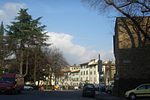Jewish monumental cemetery, Florence
Cemeteries in FlorenceCemeteries in Italy
The Jewish monumental cemetery in Florence (Cimitero monumentale ebraico) is a monumental cemetery on the current Ariosto avenue, just outside the ancient Renaissance walls, as it was not allowed to bury Jews in the city. It is open once a month, only on last Sundays, with two guided tours in the morning.
Excerpt from the Wikipedia article Jewish monumental cemetery, Florence (License: CC BY-SA 3.0, Authors).Jewish monumental cemetery, Florence
Via Francesco Berni, Florence Quartiere 4
Geographical coordinates (GPS) Address Nearby Places Show on map
Geographical coordinates (GPS)
| Latitude | Longitude |
|---|---|
| N 43.769444444444 ° | E 11.238611111111 ° |
Address
Cimitero monumentale ebraico
Via Francesco Berni
50123 Florence, Quartiere 4
Tuscany, Italy
Open on Google Maps











